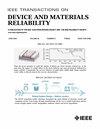探索高效安全访问 IJTAG 网络的非 TAP 接口
IF 2.5
3区 工程技术
Q2 ENGINEERING, ELECTRICAL & ELECTRONIC
IEEE Transactions on Device and Materials Reliability
Pub Date : 2024-08-07
DOI:10.1109/TDMR.2024.3440059
引用次数: 0
摘要
IEEE标准1687 (IJTAG)通过IEEE标准1149.1 (JTAG)的测试访问端口(TAP)控制器实现对片上仪器的有效访问。然而,诸如物理尺寸、制造复杂性和成本考虑等实际限制通常会给分配专用于TAP使用的测试IO引脚带来挑战,特别是在资源受限的ic中。为了规避这些限制,IEEE标准P1687.1探索了利用功能端口的替代方法,如内部集成电路(I2C),通用异步收发器(UART)和串行外设接口(SPI),作为非tap设备接口。最近,提出了一种利用UART作为设备接口访问片上仪器的协议。但是,该协议的缺点是访问时间和数据开销过大,并且缺乏安全考虑。为了解决这些问题,本文提出了一种低成本、安全的访问协议。该协议能够最大限度地减少访问时间和数据开销,分别减少45.51%和69.66%,并且产生最小的面积开销。此外,该协议集成了基于数据加密的健壮的安全措施,阻止本地和远程入侵者通过IJTAG网络窃取有用的信息。本文章由计算机程序翻译,如有差异,请以英文原文为准。
Exploring Non-TAP Interfaces for Efficient and Secure Access to IJTAG Network
The IEEE Std. 1687 (IJTAG) enables efficient access to on-chip instruments through the Test Access Port (TAP) controller of IEEE Std. 1149.1 (JTAG). However, practical constraints such as physical size, manufacturing intricacies, and cost considerations often pose challenges in allocating test IO pins exclusively for TAP usage, especially in resource constraint ICs. To circumvent these limitations, the IEEE Std. P1687.1 explores alternative means of utilizing functional ports, such as Inter-integrated Circuit (I2C), Universal Asynchronous Receiver-Transmitter (UART), and Serial Peripheral Interface (SPI), as non-TAP device interfaces. Recently, a protocol that utilizes UART as a device interface to access on-chip instruments has been proposed. However, this protocol suffers from excessive access time and data overhead and lacks security considerations. To address these issues, this paper presents a low-cost, secure access protocol. The proposed protocol is able to reduce the access time and data overhead by a maximum of 45.51% and 69.66%, respectively, and it incurs a minimal area overhead. Additionally, the protocol integrates robust security measures based on data encryption, thwarting both local and remote intruders from stealing useful information over the IJTAG network.
求助全文
通过发布文献求助,成功后即可免费获取论文全文。
去求助
来源期刊

IEEE Transactions on Device and Materials Reliability
工程技术-工程:电子与电气
CiteScore
4.80
自引率
5.00%
发文量
71
审稿时长
6-12 weeks
期刊介绍:
The scope of the publication includes, but is not limited to Reliability of: Devices, Materials, Processes, Interfaces, Integrated Microsystems (including MEMS & Sensors), Transistors, Technology (CMOS, BiCMOS, etc.), Integrated Circuits (IC, SSI, MSI, LSI, ULSI, ELSI, etc.), Thin Film Transistor Applications. The measurement and understanding of the reliability of such entities at each phase, from the concept stage through research and development and into manufacturing scale-up, provides the overall database on the reliability of the devices, materials, processes, package and other necessities for the successful introduction of a product to market. This reliability database is the foundation for a quality product, which meets customer expectation. A product so developed has high reliability. High quality will be achieved because product weaknesses will have been found (root cause analysis) and designed out of the final product. This process of ever increasing reliability and quality will result in a superior product. In the end, reliability and quality are not one thing; but in a sense everything, which can be or has to be done to guarantee that the product successfully performs in the field under customer conditions. Our goal is to capture these advances. An additional objective is to focus cross fertilized communication in the state of the art of reliability of electronic materials and devices and provide fundamental understanding of basic phenomena that affect reliability. In addition, the publication is a forum for interdisciplinary studies on reliability. An overall goal is to provide leading edge/state of the art information, which is critically relevant to the creation of reliable products.
 求助内容:
求助内容: 应助结果提醒方式:
应助结果提醒方式:


